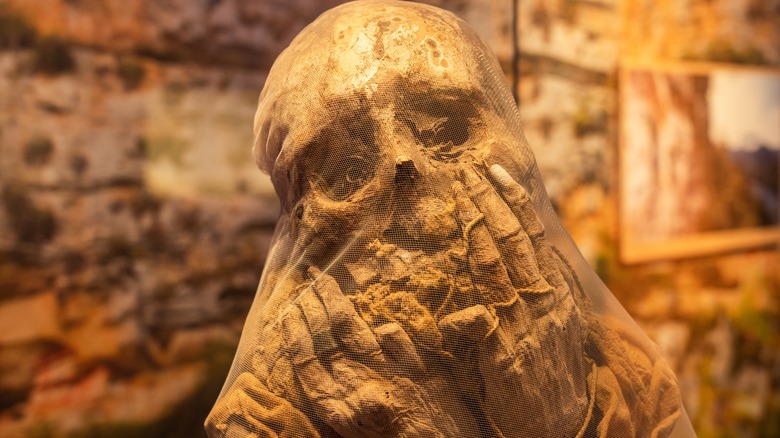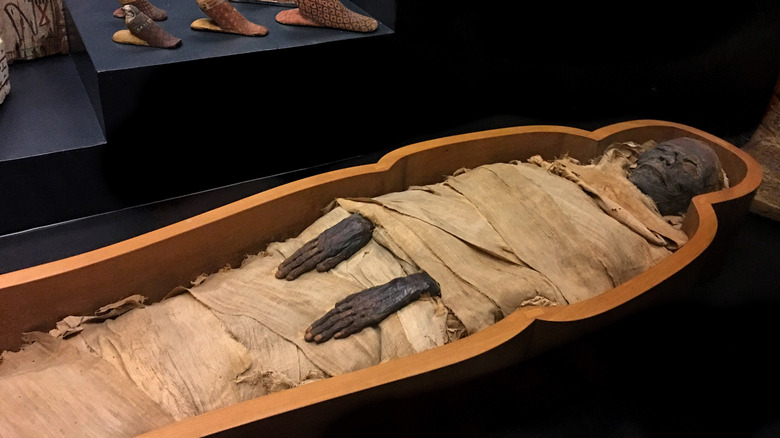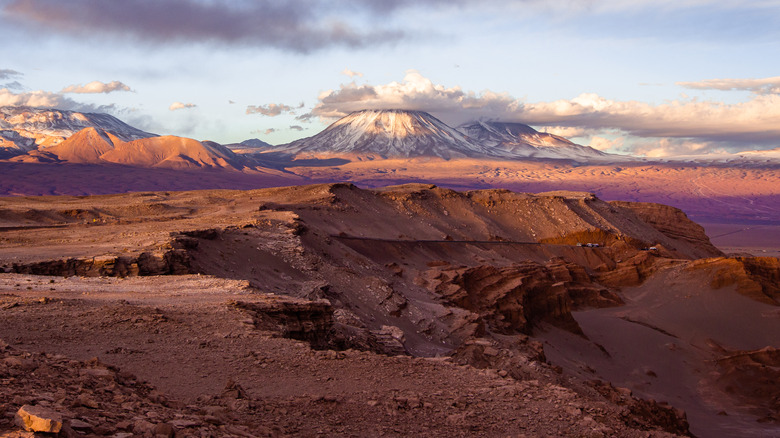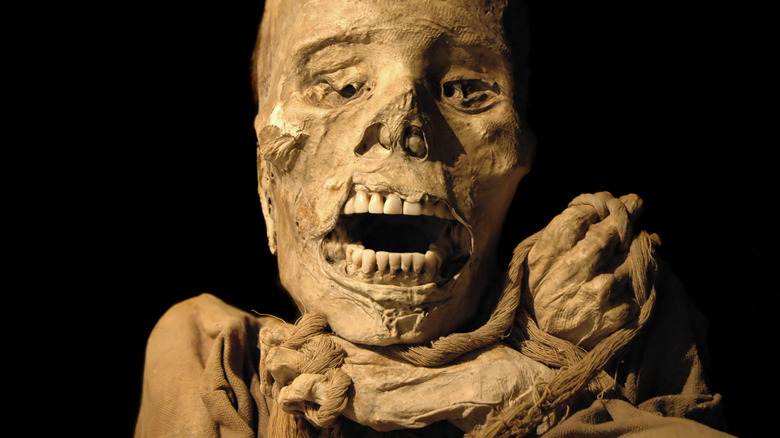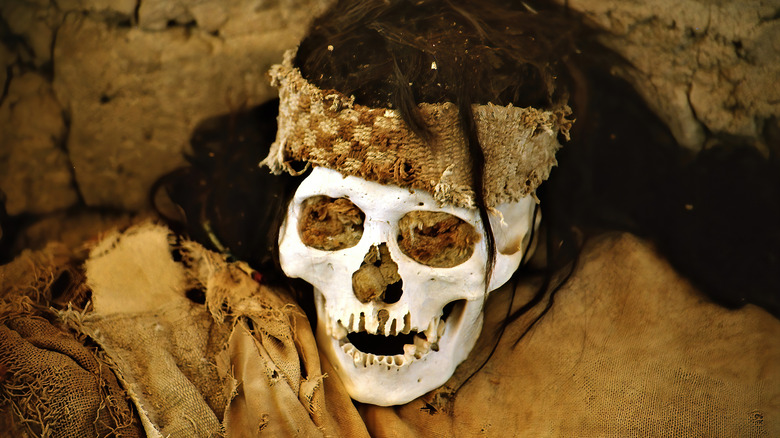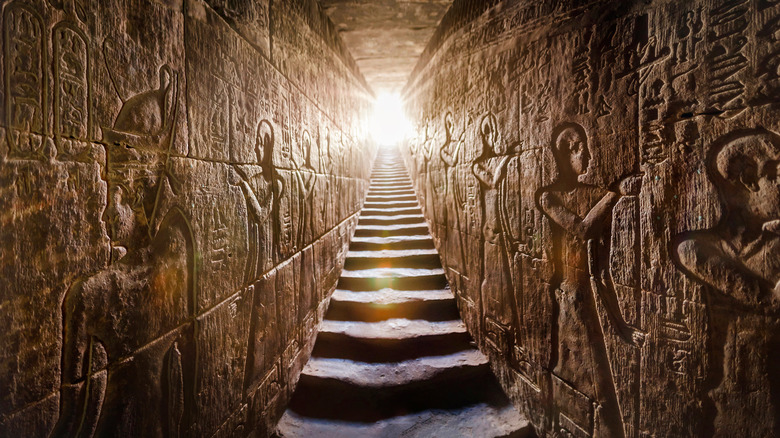The Differences And Similarities Between Egyptian Mummies And South American Mummies
When people think of mummies, what first comes to mind may be the gilded sarcophagi of Tutankhamun and Ramses II. Or perhaps the pyramids of Giza and the long aisles of white, gold, and crimson tomb art also spring to mind. But few people realize that mummification has been used by cultures outside of Egypt for millennia. The practice even predates the first Egyptian mummies by more than 2,000 years and traces back to South America. One might think the earliest mummies emerged out of a desire to preserve society's most revered members — like in the case of Egypt — but this is not so. In fact, the first people to mummify their dead were humble hunter-gatherers known as the Chinchorro culture who survived on the coast of the Atacama Desert (via Britannica).
Andean civilizations like the Inca and Nazca people also practiced mummification many centuries after the hunter-gatherers of the Atacama began the practice. For these large-scale societies, status and human sacrifice played a role in this burial method, while in Egypt, it was similarly designed to preserve important royals for the afterlife. The Chinchorro used mummification in equal measure for men, women, children, and even fetuses. As such, when we glimpse into the realm of ancient and prehistoric mummies, we see many unexpected motives and innovative means of keeping the dead preserved, per History.
History of Egyptian Mummification
The ancient Egyptians practiced mummification beginning around 3500 B.C. (per World History Encyclopedia). The reason for this type of mortuary practice was to aid in one's passage to the underworld — ruled by the god Osiris. The ancient Egyptian religion dictated that the afterlife was located near the tomb, and therefore, the dead were never far from the living (via Britannica). Much fear surrounded death, which led to rituals that treated death like "a robber," according to Egyptologist Edward Wente. Wente cites grim lines from mortuary literature, such as (via Expedition Magazine), "He has gone to the land of eternity and darkness in which there is no light." This fear extended to the afterlife, as Egyptians even had spells to prevent a second death.
Early on, they used sand, the desert sun, and shallow graves to preserve bodies, which weren't yet embalmed. But as burials deepened and more elaborate grave provisions for the afterlife were incorporated, the bodies no longer dehydrated naturally (via Expedition Magazine). Subsequently, they devised a way to mummify their dead. They did this by putting a metal rod through the nose to the brain and breaking down the brain tissue. The brain matter was then drained from the nose, and the other organs were placed in canopic jars. The empty corpse was covered in spices and palm wine, placed in natron salt, then dried for 40 days (via Britannica). The body was then wrapped in linen and topped with resin before being interred.
The Bodies of the Atacama Desert
Scientists believe that 7,000 years ago, in the arid Atacama desert of Chile and Peru, hundreds of corpses peppered the landscape inhabited by the Chinchorro culture. At a population of 100, the foraging people would have seen many corpses naturally mummified at the desert's hand. Despite agricultural societies being more likely to invent new burial methods, the Chinchorro people, who had been in the region for 3,000 years prior, were inspired by the inhospitable desert to create the first mummies. With the dead being all around the living — preserved well enough to even be recognizable, perhaps — the Chinchorro likely needed to come to terms with the world of the dead through spiritual practice (via Science).
About 282 Chinchorro mummies have been recovered, with 149 of them intentionally mummified (via Archaeology Magazine). The process differed greatly from the Egyptians. They similarly removed the organs, but the Chinchorro also defleshed the bone. Once done, they reassembled the skeleton with a framework of wooden sticks, then replaced the organs with camelid fibers, clay, and dried plants. Plants were also used to recreate the muscles. The skin was then put back on the corpse, with sea lion skin used to patch any gaps. Clay masks and wigs were then placed on the head of the mummy. Another key difference between the Chinchorro and the Egyptians is that Chinchorro mummies were not entombed. Rather, they kept the portable bodies of women, men, and children within the family.
The Inca's Imperial Mummies
Like the Egyptians, the Inca gave preference to high members of society, especially emperors, who were treated as if they were alive well after their demise. Adorned in the finest textiles and jewelry, the mummies were well tended to, even receiving food and drink. But if this sounds similar to Egyptian philosophy, aspects of Incan mummification were certainly distinct from their counterparts in the Middle East. Incan mummies, like many Andean mummies, were encased in leather or cloth in a fetal position so as to firmly bundle them. By ensuring their physical stillness, they would enable their spiritual agility through time and the living world (via History). The implication is that the Incan mummies remained close to the Earth and their living descendants.
By the 15th century, the Inca Empire reigned and conquered other Andean peoples. Their leaders held imperial status, justified by a celestial relationship to the sun, of which the emperor claimed to be a direct descendent. They used their concept of linking past and present to aid in their conquests of other cultures. When they incorporated a new society into their empire, they claimed their dead and brought them to the capital of Cuzco for rituals, per History. But mummification also factored into sacrifices to the gods, as the well-preserved girl known as "The Maiden" proved when her 500-year-old remains turned up in the Andes Mountains in 1999 (via National Geographic).
Mummies of Nazca
Much like the Inca, the Peruvian culture called the Nazca (who also constructed the mysterious geoglyphs called the Nazca Lines) practiced a form of sacrificial mummification. Severed heads, sometimes speculated to be war trophies, appear in the archaeological record of the ancient culture. But the reason for the apparent trophy heads and many of the grave goods remains murky, per the American Museum of Natural History. This year, Live Science reported that some human sacrifices ingested hallucinogens prior to their deaths. The subject of the study was a child whose head was preserved and whose hair samples showed traces of coca leaves and San Pedro cactus — a strong psychotropic plant used between 100 B.C. to A.D. 450. The head was from one of 22 bodies recovered from a group of human remains (a mix of both children and adults).
Like the Inca, the Nazca people bundled many of their mummies before burial. In 2021, archaeologists discovered a Nazca mummy of 800-1200 years old that was tied in a fetal position with heavy rope (per the New York Post). Surprising as this was, the archaeologists believe it was a funerary practice of Southern Peru and nothing more sinister. In fact, the individual was likely high-ranking since he was buried with ceramics, vegetables, and stone tools, with mollusks placed outside the grave as a food offering. The offerings continued for many years, indicating that the Nazca, like the Inca, didn't see death as the end.
Religious Similarities and Differences
The ancient Egyptians had the advantage of historical texts they left behind, notably the Book of the Dead. Beliefs of South American civilizations are harder to decipher because knowledge of their religions didn't carry through the ages as thoroughly. The Spanish recorded information about the Incan empire, but societies dominated by civilizations like the Inca have hazier histories. According to Britannica, animism was integral to their religion, with Inti as their sun god and Apu Illapu as the god of agriculture. With drought plaguing the Inca periodically, Apu Illapu was often gifted with human sacrifices that archaeologists recovered hundreds of years later. Given the similarities between Incan and Nazca mummification practices, there may have been some similarities in their religious beliefs.
Egyptians similarly practiced polytheism for most of their history and regularly made offerings to mummified remains, per Expedition Magazine. Thus, perhaps the starkest differences exist between the Egyptians and the Chinchorro culture. They differed not only in methods of preservation and burial but also in social structure. Large-scale societies share some similarities regarding status, wealth, and power. However, the Chinchorro, like most hunter-gatherers, were egalitarian, and this was reflected in their mummification practices. But ultimately, the bone-dry deserts of South America and Egypt designed a similar natural preservation of the dead, which haunted the areas' inhabitants and led to beliefs that blurred the lines between the living and the dead.
